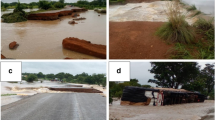Abstract
The objective of this study is to demarcate the groundwater potential areas in sub-upper Krishna basin (SUKB). Geospatial technology applications viz. remote sensing and geographic information system (GIS) were utilized to generate the groundwater prospects map with the aid of satellite data, secondary data, web mapping services (wms) i.e. Bhuvan geoportal, and Google Earth along with requirement based field visit and ground truth, particularly while preparing a land use/land cover (LULC) map. Using these data sources input parameters which influence the occurrence of groundwater were prepared utilizing ArcGIS 10.3 and ERDAS IMAGINE image processing software. The input parameters generated were geomorphology, geology, LULC, slope, lineament density, drainage density, and rainfall. Each parameter was treated as a GIS raster theme with a number of features. Each feature of the theme was ranked and weights were assigned to the themes according to their role in influencing the occurrence of groundwater. The ranks and weights were assigned on the basis of opinions of experts in their respective fields and by referring the previous research work on groundwater prospect mapping. All the themes were integrated and Weighted Overlay Model was built in ArcGIS to generate the groundwater prospects map of SUKB. It is found that very good to moderate groundwater potential zones are clustered near the water bodies, cropland, and in floodplain regions of the basin while poor groundwater potential zones are located in the regions of structural origin geological features which seldom support good infiltration of water. The study revealed an exemplary result which is in good agreement with ground reality as validation using field observation data justified the authenticity of the generated groundwater potential (GWP) zones. Hence, geospatial technology application is worthy for mapping the groundwater potential zones which would be further utilized to pinpoint the locations for geophysical investigations for groundwater exploration in the basin.
Similar content being viewed by others
References
Arkoprovo, B., Adarsa, J. and Prakash, S.S. (2012) Delineation of Groundwater Potential Zones using Satellite Remote Sensing and Geographic Information System Techniques: A Case study from Ganjam district, Orissa, India. Research Jour. Recent Sciences, v.1(9), pp.59. Retrieved from https://doi.org/www.isca.in
Elbeih, S.F. (2014) An overview of integrated remote sensing and GIS for groundwater mapping in Egypt. Ain Shams Engineering Jour., v.6(1), pp.1–15. DOI: https://doi.org/10.1016/j.asej.2014.08.008
Gnanachandrasamy, G., Zhou, Y., Bagyaraj, M., Venkatramanan, S., Ramkumar, T. and Wang, S. (2018) Remote Sensing and GIS Based Groundwater Potential Zone Mapping in Ariyalur District, Tamil Nadu. Jour. Geol. Soc. India, v.92(4), pp.484–490. DOI: https://doi.org/10.1007/s12594-018-1046-z.
Geology of India, (2019) Retrieved from: https://en.wikipedia.org/wiki/Geology_of_India
Harini, P., Sahadevan, D.K., Das, I.C., Manikyamba, C., Durgaprasad, M. and Nandan, M.J. (2018) Regional Groundwater Assessment of Krishna River Basin Using Integrated GIS Approach. Jour. Indian Soc. Remote Sensing, v.46(9), pp.1365–1377. DOI:https://doi.org/10.1007/s12524-018-0780-4
Hutti, B. and R. Nijagunappa (2011). Identification of groundwater potential zone using geoinformation in Chataparabha, North Karnataka. Internat. Jour. Geometrics and Geosciences, v.2(1), pp.91.
Ibrahim-Bathis, K. and Ahmed, S.A. (2016) Geospatial technology for delineating groundwater potential zones in Doddahalla watershed of Chitradurga district, India. Egyptian Jour. Remote Sensing and Space Sci., v.19(2), pp.223–234. DOI: https://doi.org/10.1016/j.ejrs.2016.06.002.
Jha, M.K., Chowdhury, A., Chowdary, V.M. and Peiffer, S. (2007) Groundwater management and development by integrated remote sensing and geographic information systems: Prospects and constraints. Water Resources Management, v.21(2), pp.427–467. DOIhttps://doi.org/10.1007/s11269-006-9024-4
Kumar, M.G., Agarwal, A.K. and Bali, R. (2008). Delineation of potential sites for water harvesting structures using remote sensing and GIS. Jour. Indian Soc. Remote Sensing, v.36(4), pp.323–334. DOI: https://doi.org/10.1007/s12524-008-0033-z
Lattman, L.H. and Parizek, R.R. (1964) Relationship between fracture traces and the occurrence of groundwater in carbonate rocks. Jour. Hydrol., v.2, pp.73–91.
Lineaments (2019). Retrieved from: https://en.wikipedia.org/wiki/Lineament
Magesh, N.S., Chandrasekar, N. and Soundranayagam, J.P. (2012) Delineation of groundwater potential zones in Theni district, Tamil Nadu, using remote sensing, (GIS) and (MIF) techniques. Geoscience Frontiers, v.3(2), pp.189–196. DOI: https://doi.org/10.1016/j.gsf.2011.10.007
Magesh, N.S. and Chandrasekar, N. (2016) A Fuzzy — GIS Model for the exploration of groundwater potential zones in Tamiraparani sub-basin, Tamil Nadu, Front. Cur. Trends. Engg. Tech., v.1(2), pp.52–58. Retrieved from: https://doi.org/www.fctet.in
Manual of Ground Water Prospects Mapping, (2008). Rajiv Gandhi National Drinking Water Mission, National Remote Sensing Agency.
Oikonomidis, D., Dimogianni, S., Kazakis, N., & Voudouris, K. (2015) A GIS/Remote Sensing-based methodology for groundwater potentiality assessment in Tirnavos area, Greece. Jour. Hydrol., v.525, pp.197–208. DOI: https://doi.org/10.1016/j.jhydrol.2015.03.056
Ratna, S.B. (2012) Summer monsoon rainfall variability over Maharashtra, India. Pure Appl. Geophys., v.169, pp.259–273
Senanayake, I.P., Dissanayake, D.M.D.O.K., Mayadunna, B.B., and Weerasekera, W.L. (2016) An approach to delineate groundwater recharge potential sites in Ambalantota, Sri Lanka using GIS techniques. Geoscience Frontiers, v.7(1), pp.115–124. DOI:https://doi.org/10.1016/j.gsf.2015.03.002
Shekhar, S. and Pandey, A.C. (2015) Delineation of groundwater potential zone in hard rock terrain of India using remote sensing, geographical information system (GIS) and analytic hierarchy process (AHP) techniques. Geocarto International, v.30(4), pp.402–421. DOI: https://doi.org/10.1080/10106049.2014.894584
Srinivasa Rao, Y. and Jugran, D.K. (2003) Delineation of groundwater potential zones and zones of groundwater quality suitable for domestic purposes using remote sensing and GIS. Hydrol. Sci. Jour., v.48(5), pp.821–834. DOI:https://doi.org/10.1623/hysj.48.5.821.5145
Soil Survey Information (2019). Department of Agriculture, Maharashtra State. Retrieved from: http://krishi.maharashtra.gov.in/1001/Home
Suhag, R. (2016) Overview of Ground Water in India. PRS On Standing Committee On Water Resources, Legislative Research, (February), 12p.
Waikar, M.L., Nilawar, A.P., (2018) Identification of Ground Water Potential Zone Using Remote Sensing and GIS Techniques. Internat. Jour. Advanced Res., v.6(5), pp.948–953. DOI: https://doi.org/10.21474/ijar01/7116
Author information
Authors and Affiliations
Corresponding author
Rights and permissions
About this article
Cite this article
Ashtekar, A.S., Mohammed-Aslam, M.A. Geospatial Technology Application for Groundwater Prospects Mapping of Sub-Upper Krishna Basin, Maharashtra. J Geol Soc India 94, 419–427 (2019). https://doi.org/10.1007/s12594-019-1331-5
Received:
Accepted:
Published:
Issue Date:
DOI: https://doi.org/10.1007/s12594-019-1331-5




